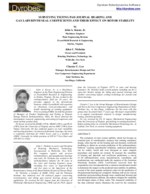Papers
“Surveying Tilting Pad Journal Bearing and Gas Labyrinth Seal Coefficients and Their Effect on Rotor Stability,” |
Abstract
The evaluation of rotor system stability, which has become an essential part of rotordynamic analyses and rotating machinery design, relies heavily on the bearing and seal dynamic coefficient modeling to obtain an accurate prediction of the turbomachinery behavior. Lacking experimental validation, analytical predictions can be widely varied and even divergent as more complex procedures and models are created. To measure the variability of bearing and labyrinth seal coefficient predictions, a survey of 60 turbomachinery users, manufacturers, consultants, and academicians was conducted under the auspices of the American Petroleum Institute (API). Coefficients received from the respondents were incorporated into a common rotordynamic model to determine the impact on the predicted rotor stability. In addition, several of the most popular analytical codes for the prediction of tilt pad journal bearings are compared. Starting with an iso-viscous prediction and proceeding through more complicated thermal and structural deformation solutions, the authors compare the variability and divergent nature of these codes. The measured variability of the data collected clearly illustrates the need for the resolution of fundamental bearing issues (i.e., synchronously versus nonsynchronously reduced bearing coefficients) and labyrinth seal predictions based on repeatable experimental data.

